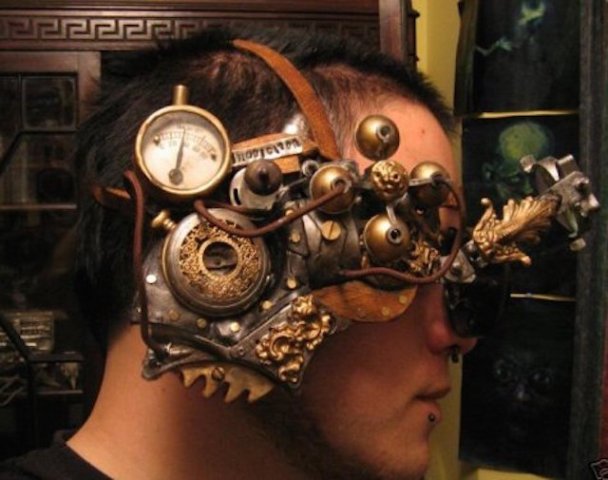
(via)
Apparently, steampunk was “over” before I ever discovered that it existed, and it seems that since I’ve been a fan, it’s died a few more times. For some reason, people who write articles about things (AKA people like me!) have been killing off steampunk for several years now, but it just keeps getting new mechanical parts attached and keeps on ticking like a well-wound pocket watch. It seems to have died back in 2010, and again just last year, and yet … I keep wearing and selling steampunk pieces and costumery at conventions, and no one has called me a zombie or a relic yet!
In fact, most people are excited to see it, even when they don’t understand what it is. There’s something appealing about re-purposed parts, jewelry with exposed cogs, and wearing Victorian-inspired corsetry with a teal-green wig. Because of my own cosplay preferences and because I’m often seated at a table in the middle of a crowded hall, surrounded by steampunk items—and also because I’m pathologically friendly at conventions—I am often asked to explain what steampunk is. To bastardize the popular “definition” of pornography: I may not know definitively what is steampunk, but … I know it when I see it. I’ve even been informed that steampunk is over and outdated (while selling steampunk items to customers) at my table. The steampunk Iron Man, the steampunk vampire lady, and the guy who rigged his own mechanical wings would help me to beg to differ, good sirs and madams!
Okay, so what the heck is steampunk, and where did it start? Fair enough. Steampunk has its roots in the Victorian era and the fantastical works of such authors as Jules Verne (Around the World in Eighty Days, The Steam House, and 20,000 Leagues Under the Sea), H.G. Wells (The Invisible Man, The Time Machine), and even Mary Shelley’s Frankenstein to some degree. The elements of time travel, mad science, combining the natural with the mechanical, and a neo-Victorian aesthetic are common, but not mandatory.
When steampunk first became a “thing” people were talking about, there were, as there always are, people who took things much, much farther than most would. You don’t have to steampunk the whole house just because you enjoy the aesthetic (but you sure can if you want to and have the time and the means!). Sometimes, enjoying steampunk is as simple as wearing a cool steampunk necklace with your regular clothes to work. As always, please keep in mind that my opinions do not define steampunk and that differing levels of investment in the steampunk community are possible and welcome!
I like to tell people that steampunk is like a what-if issue in comic books, except for a historical period. The basic premise of steampunk is that the Industrial Revolution either didn’t happen or happened differently, so instead of combustion engines and coal, clockwork and steam power the world. Time travel, steam power, clockwork, airships, goggles, mad science, and Victorian-inspired fashions are common tropes in steampunk, although there is a lot of flexibility there. Jeff Vandermeer’s book, The Steampunk Bible, cleverly assigns steampunk a formula as a means of explanation:
Steampunk = Mad Scientist Inventor [invention(steam x airship or metal man/baroque stylings) x (pseudo) Victorian setting] + progressive or reactionary politics x adventure plot.
(Steampunk Bible, pg. 9)
Steampunk encompasses a sense of longing not for the actual past, but for a futuristic past that never was, and turns that longing into artistic expressions of music, literature, art, and entertainment. Steampunk is an aesthetic, but rarely a lazy one. The DIY and repurposing aspects keep steampunk a flexible, malleable form of expression with a spirit of adventure. Often, steampunk combines the Victorian era’s fascination with the natural world with the entrepreneurship of invention, giving way to such creations as the mechanical creatures in Nantes, France, the Nautilus, a submarine modeled after sea creatures in 20,000 Leagues Under the Sea, and even reinterpretations of mechanical singing bird boxes.
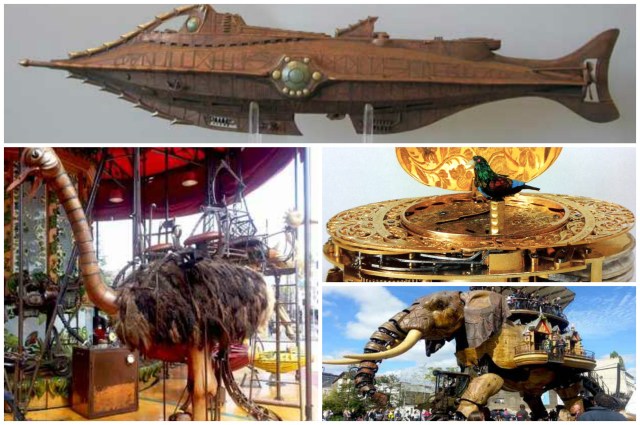
Mechanimals? I think I made a word! I like it. (via)
Steampunk doesn’t always adhere to a Victorian aesthetic/location. Popular alternates are the American West, science fiction or fantasy that takes place in space or on another planet, and alternate dimensions/universes within established canon.
Things that are “over” are not literally everywhere in popular and nerdpopular culture, as steampunk is. There are books, bands, and television to explore! Book things first. If you want to read something steampunk, I have some recommendations for you!
- Cherie Priest’s The Clockwork Century series takes place in an alternate 18060’s Seattle rife with airships, zombies, and political intrigue. The first book in the series is Boneshaker, which stars Zeke and his mother, Briar as they dodge zombies, family history, and unravel a long-hidden mystery below the Seattle-that-was. The POV of the book goes back and forth between Zeke and his mother, and I really enjoyed this aspect. It would have been easy to see Zeke as nothing more than an obnoxious kid, if the story had been told only from Briar’s perspective, and Briar might have seemed an unsympathetic character if it had only been told from Zeke’s perspective. If you want your steampunk served up American style with guns and zombies, Boneshaker is a great place to start.
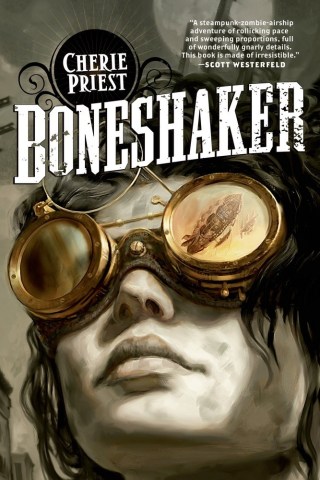
Airships, zombies, goggles, and guns!
- Phil and Kaja Foglio’s Hugo Award-winning Girl Genius graphic novel/online comic/novel series tells the story of Agatha Heterodyne, a young woman who possesses incredible powers of mad, mad science in a world of airships, science, and adventure. Creator Kaja Foglio prefers to call it a “gaslamp fantasy,” rather than labeling it as strictly steampunk, because she wants to play up the fantastical elements of the story. Agatha is a smart, funny character and well worth getting to know, whether you want to call her steampunk or not.
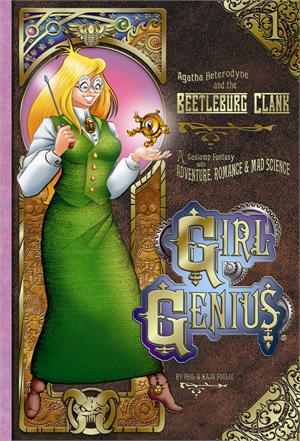
Her name is Agatha, and she totally rocks it!
- Scott Westerfeld’s Locus Award-winning Leviathan is set in a alternative historical World War I, featuring a conflict between the Clankers and the Darwinists. It has just enough history in it to make it ring oddly familiar (the main character, Aleksander, is the son of the Archduke Ferdinand) and just enough fantastical machinery to make it unmistakably steampunk.
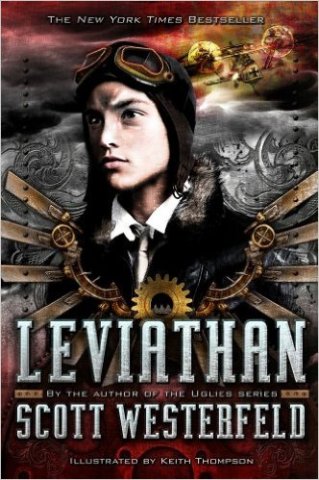
- Kenneth Oppel’s Airborn takes place mainly on board an airship in an alternate history where the airplane was not invented. Cabin boy Matt and passenger Kate get to know each other while unraveling the mystery of possible flying panther-people. This one was a serendipitous library find for me, and I just found out while writing this article that there are sequels! So excited!
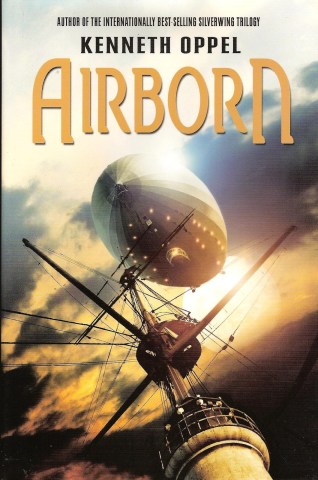
There are tons of other steampunk and steampunk-inspired books out there. Some other recommendations include author Philip Reeve’s Mortal Engines Quartet and the Fever Crumb prequels, Gail Carriger’s The Parasol Protectorate series, as well as Philip Pullman’s His Dark Materials series. Different books definitely embrace different aspects of steampunk, so don’t expect homogeneity across the individual series.
So … books are the easy part! Now, we’re off into music territory. What does steampunk sound like? Can a band be steampunk, too? I like to think, like with literature, that musicians can embrace a steampunk aesthetic, cover certain topics known to attract an audience that enjoys steampunk, and can make use of instruments and sounds from other eras, or even create new ones. A band can have a steampunk song, but not consider themselves an entirely steampunk band. So, to avoid pigeonholing the musicians and their fans, I’m going to just say that there are certain groups that embrace the aesthetic more than others and make recommendations based on that.
- The Cog is Dead fully embraces their image as a steampunk band. There is a fictional backstory, the band members take on fictional personalities, and their songs form a story arc about the adventures of their crew of time travelers from 1893. They started out as a studio-recording band only, but kept receiving offers to gig and perform with other steampunk groups, including opening for the mainstay of steampunk music, Abney Park. The band consists of Captain John Sprocket (John Mondelli) on guitar, lead vocals, ukulele, accordion, and other instruments as well, Bradley Harrington, III (Bradley Whalen) on backup vocals and bass, and newest member Renate Goodwin (Renate Eights) on drums. I discovered them via Spotify, and if you have interest in listening to them, I recommend visiting their official website and listening to the song “The Death of the Cog.”
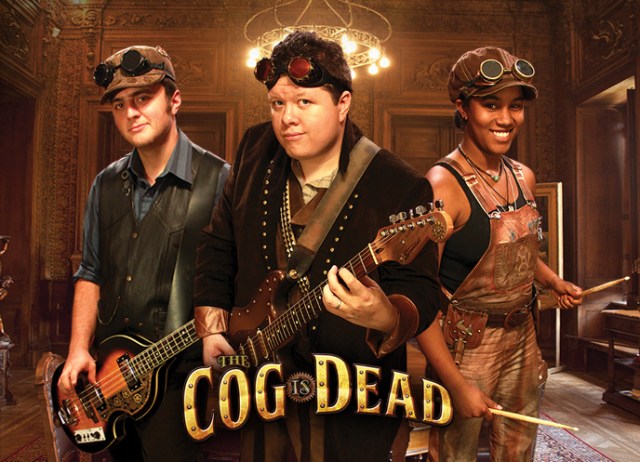
The Cog is Dead
- Abney Park is definitely one of the oldest steampunk bands. They got their start as a goth band and made a conscious decision in 2005 to change from goth to steampunk. They worked the changes in the band’s roster of performers into their fictional backstory, a clever move meant to lessen the impact of the changes on fans. Abney Park currently consists of Robert Brown on vocals, ukulele, accordion, bouzouki, and other instruments as well, Kristina Erickson on keyboards, Josh Goering on guitar and banjolele, Mitchel Drury on violin, and Derek Brown on bass. Abney Park is the steampunk band all of the other steampunk bands want to open for, and they have received the most media attention, even having a song featured on True Blood, the HBO series. My personal favorite Abney Park song is “The Wake,” which is featured on the Taxidermy album. I also recommend Airship Pirates. For reasons that in no way pertain to my love of TaleSpin and the character of Don Karnage … but I digress.
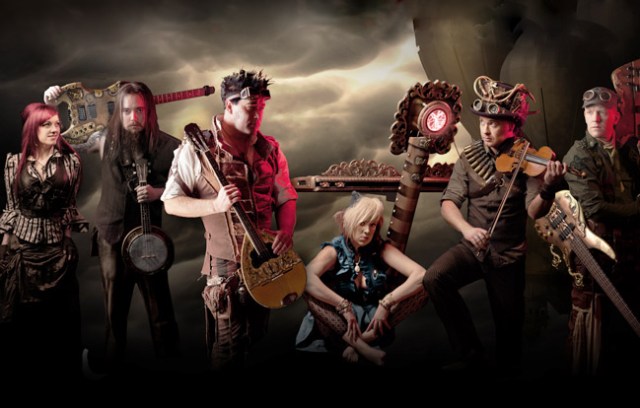
Abney Park
- Last, but never least, we have Steam Powered Giraffe, which is my favorite steampunk-inspired group to listen to. Unlike Abney Park and The Cog is Dead, Steam Powered Giraffe does not consider themselves a primarily a steampunk band. They embrace the steampunk aesthetic, and, like the aforementioned groups, have fictional backstories and characters, but part of their story is that they are robots who have been performing music since the early 1900s and continue to perform. Because the “robots” have been collecting styles of music since the early 1900s and have been consistently performing through the forties, fifties, nineties, etc., they have more styles of music under their belts as performers than are encompassed by the label of “steampunk,” hence, steampunk is only a part of Steam Powered Giraffe’s image. The band’s lineup consists of: The Spine (David Michael Bennett) on guitar, bass, keyboards, and vocals, Rabbit (Isabella “Bunny” Bennett) on melodica, accordion, and vocals, and Hatchworth (Sam Luke) on bass, drums, guitar, and vocals. Steve Negrete is their sound engineer. A good starting place for listening to Steam Powered Giraffe would be their “Honeybee” video or the Western-inspired “Automatonic Electronic Harmonics.”
Of course, there are other bands with varying degrees of steampunk influence, but these are my top three recommendations to begin exploring steampunk through music. All three of these bands are currently working, recording, and have multiple albums available for purchase, which I would consider yet another sign that the rumors of the death of steampunk have been greatly exaggerated. Dead bands tell no tales, and these bands are spinning yarns like Clotho, Lachesis, and Atropos just ain’t no thing.
The steampunk aesthetic has been finding its way from literature and music into mainstream television and movies as well. Howl’s Moving Castle, the Hayao Miyazaki movie based on the novel by Diana Wynne Jones, borrows heavily from steampunk. The moving castle even seems to kind of have a face, if you look at it a certain way, calling to mind such Victorian and neo-Victorian fascinations blending the natural and the mechanical. The moving castle is powered by Calcifer’s magic and essence, the blend of nature, magic, and science that embodies steampunk.
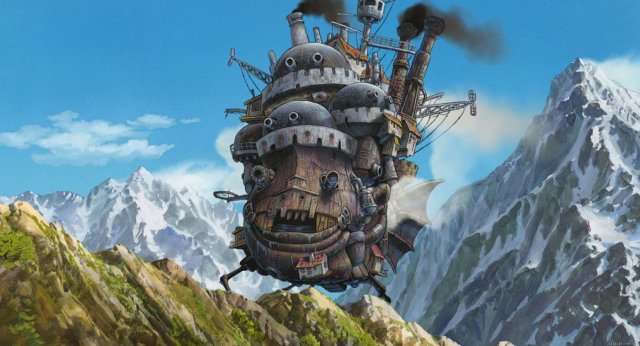
Powered by magic, steam, and … some heart. Yeah.
Hugo, the 2011 movie based on the novel by Brian Selznick, embraces the steampunk aesthetic in its fascination with clockwork, particularly with the automaton.
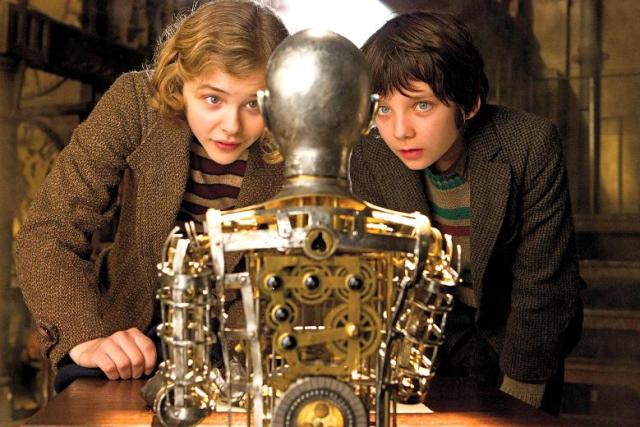
So … are we steampunking right now? Yes. Yes, I believe we are.
Warehouse 13, the SyFy series that ran from 2009-2014 (kind of a long time for a SyFy show) featured steampunk more heavily than any other television show I can think of. From Tesla to Farnsworth to a female H.G. Wells, Warehouse 13 kept the gadgetry and neo-Victorian-mad-science going for almost five years, which, in SyFy Network time, is comparable to like, a decade or something, right? Time travel joke, anybody?
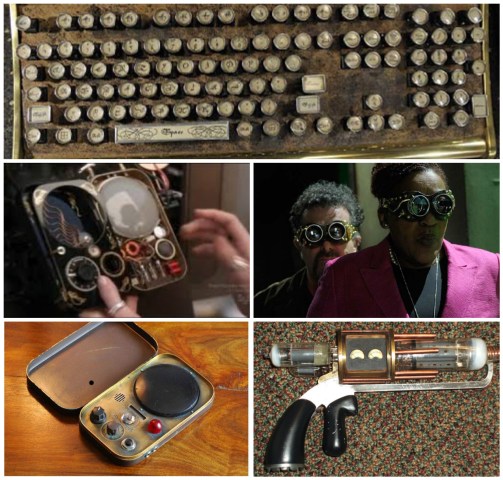
Teslas, Farnsworths, goggles, and steampunked keyboards!
Other examples of steampunk in popular culture could include the Robert Downey Jr. Sherlock Holmes movies, which I am convinced is the inspiration for all of the steampunk Iron Man cosplay I keep seeing. Seriously, Google it. There is some amazing cosplay talent at work there! Sky Captain and the World of Tomorrow, Jack and the Cuckoo-Clock Heart, Atlantis: The Lost Empire, Steam Boy, Wild Wild West, The League of Extraordinary Gentlemen, Tin Man, and The Golden Compass all contain at least elements of steampunk or steampunk inspiration, and that, to me, is evidence that steampunk is not dead, but going strong and integrating itself seamlessly into increasingly mainstream areas of society. The Game Show Network released a reality TV show called Steampunk’d just this year, where DIY steampunk enthusiasts, crafters, makers, etc. compete against each other for prizes.
One of the best things about steampunk is that, as a rule, its fans are not afraid of making fun of themselves. Humorous acts such as Professor Elemental, a self-described chap-hop rap artist, make songs like “Fighting Trousers.” Also, Reginald Pikedevant’s “Just Glue Some Gears On It and Call It Steampunk,” pokes gentle fun at steampunk culture and the troubles that arise as its popularity increases.
And, no one should go through life without laying eyes on Katherine Stewart’s Lady Has Bustle, a fabulously body-positive parody of Baby Got Back, that never, ever fails to crack me up. Especially the part at about the 2:25 mark about how too many steampunks are so hung up on trying to define steampunk that they fail to understand that at the end of the day, it’s all about having a good time.
*Previously, I had stated that the song, “Just Glue Some Gears On It (and call it Steampunk) was by Professor Elemental, but it is, in fact, by Reginald Pikedevant. Apparently, this mistake is so common that Mr. Pikedevant has actually written a song about it. Have a look at Belated Introduction if you are so inclined!
Sara Goodwin has a B.A. in Classical Civilization and an M.A. in Library Science from Indiana University. Once she went on an archaeological dig and found awesome ancient stuff. Sara enjoys a smorgasbord of pan-nerd entertainment such as Renaissance faires, anime conventions, steampunk, and science fiction and fantasy conventions. In her free time, she writes things like fairy tale haiku, fantasy novels, and terrible poetry about being stalked by one-eyed opossums. In her other spare time, she sells nerdware as With a Grain of Salt Designs, Tweets, and Tumbls.
—Please make note of The Mary Sue’s general comment policy.—
Do you follow The Mary Sue on Twitter, Facebook, Tumblr, Pinterest, & Google +?



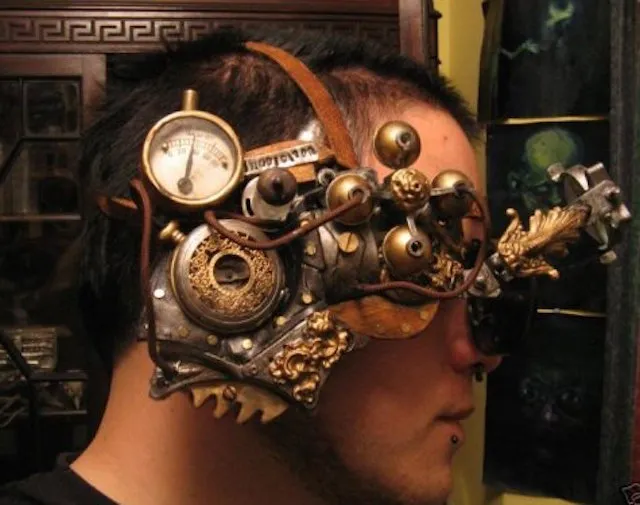
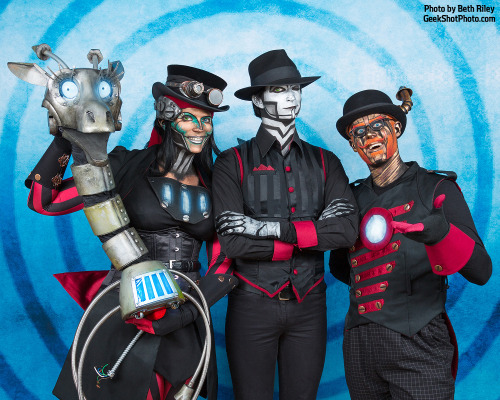





Published: Dec 23, 2015 11:20 am